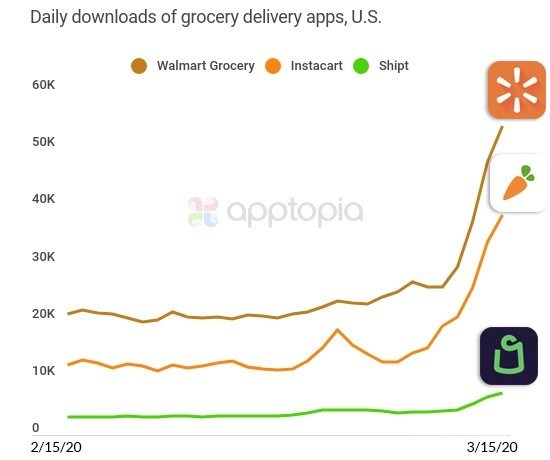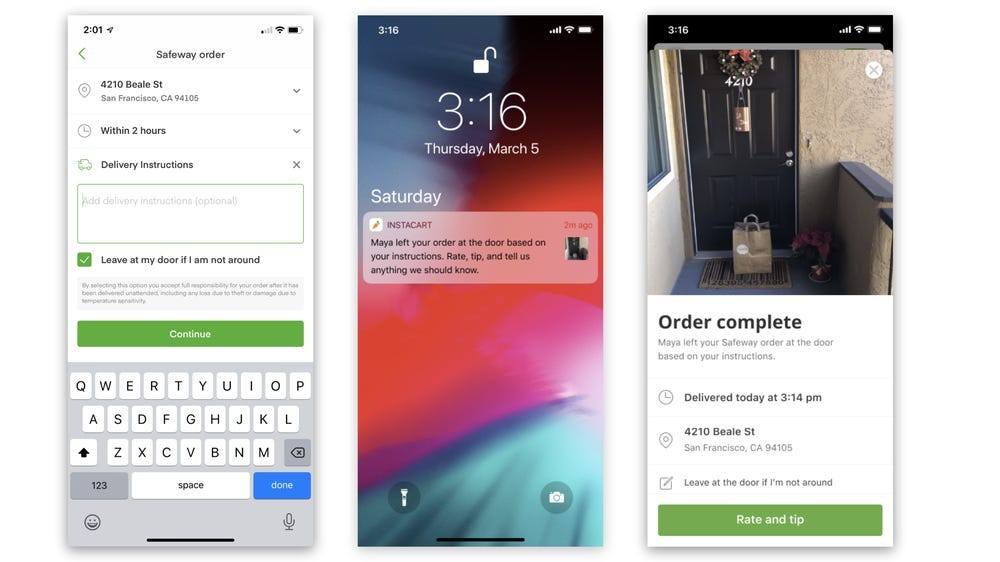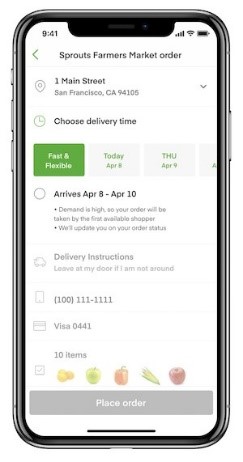Instacart sees unprecedented growth amid pandemic: can it deliver?

As COVID-19 pandemic forced people to social distance, consumers started eating more at home which created huge demand for delivery services applications. Specifically, the grocery delivery services industry has managed to capture a lot of the new demand as home cooking proved to be more affordable than food delivery and became a way for people to kill time as they stayed at home. As a result, industry experts anticipate an increase of 7.6% in the Grocery Delivery industry revenues compared to 2019 to reach a total size of $5.5 billion.1 Instacart, a leading player in this space which delivers from 25,000+ stores in 5,000+ cities in North America, has seen a huge surge in its app downloads which were up by 218% in March 2020 compared to the previous month.2


But along with this huge growth, came scalability problems for Instacart that was unable to service a lot of the requests in the beginning and whose website was down a couple of times. So can Instacart handle this new demand? What can it do to maintain its leading position during this outbreak and will it be able to sustain this growth post-COVID?
Growth experienced during the outbreak
The ~$8 billion San Francisco-based company has seen a huge surge in its sales amid the COVID-19 pandemic as order volume jumped 300% from last year and customer basket size grew by 25% due to “panic-ordering”. Instacart generated $700 million in sales for each of the first two weeks of April and is expecting ~$10 million in net profit for that month . This will be the first time ever Instacart reports profit as it lost ~300 million in the year 2019.3
As a direct response to COVID-19, Instacart released the following new services to adhere to health guidelines and manage increased demand:
- “Leave at My Door Delivery”: Instacart rolled out this new feature to allow its customers to receive orders without having to interact with their personal shopper in order to reduce human contact and increase flexibility. This new service both protects Instacart employees who are constantly exposed to the virus and appeals to customers who are worried about their safety and prefer to limit contact with strangers.

- “Fast & Flexible and Order Ahead”: with these new tools, customers don’t have to schedule a specific delivery window anymore. They can either order ahead of a couple of weeks, which is very convenient for customers who can now anticipate their pantry needs due to the Coronavirus, or they can make an order and it will be efficiently matched with the first available personal shopper. Tests have shown that these new features can increase available delivery windows by 50% and can improve delivery speed.4 This feature also helped Instacart manage demand without restricting itself to specific time slots and hence, reducing the limitations caused by its gig workers’ availability.

“Prescription delivery with Costco”: Instacart has partnered with Costco to launch a new prescription delivery service allowing customers to order their prescriptions online along with their groceries and deliver them with Instacart. This new service expanded the value Instacart can add to its customers during this pandemic.

Moreover, Instacart has also been increasing its manpower to respond to the surge in demand. For example, it decided to double its customer care team to 3,000 agents (up from 1,200 agents) to be able to respond to customer questions and to help resolve any delivery issues. Instacart has also hired 300,000 new personal shoppers as independent contractors to meet the growing demand and is also planning on hiring another 250,000 employees in the next couple of months.
Challenges
Despite the great growth Instacart has been seeing, it has also been experiencing some shortcomings.
Customers have been complaining about inability to place orders due to limited delivery windows, or even the lack thereof. There have also been complaints about delays in deliveries. This limitation is mainly a direct result of Instacart’s business model as the company has two forms of personal shoppers: full-time employees that are stationed in specific stores and independent contractors or gig workers which are the majority. Although it managed to “steal” workers from other gig companies who have been negatively affected by the Coronavirus pandemic such as Uber and Lyft, Instacart still doesn’t have enough workers to satisfy the surging demand.
This brings us to the second problem: gig workers rights. Instacart’s contractors have went on several strikes during the Coronavirus pandemic claiming that Instacart hasn’t been providing them with enough personal protective material like masks and hand sanitizers. Workers were also demanding higher tips or “bonuses” for risking their lives during the pandemic as well as more paid sick leaves which are currently limited to people with COVID-19 diagnosis and don’t apply to the workers who have experienced the symptoms but weren’t able to test for it due to limitations in the healthcare system.
Instacart said that it will be taking the necessary steps to address the above demands. It has already rolled out a new tool to assess whether workers are experiencing COVID-19 symptoms to ensure its employees are eligible for sick pay.
Going forward
The challenges Intacart is currently facing are completely normal for any company who wouldn’t have anticipated all this sudden growth in demand. The real challenge is Instacart’s ability to properly anticipate and satisfy demand post COVID crisis. Experts believe that this industry will continue to grow in the future as limited human contact becomes the “new normal” at least for the next couple of years and as the grocery delivery technology improves to an extent that people do not see the value in personally shopping for their goods anymore. Hence, Instacart should be able to satisfy demand and ensure flexible delivery timings for its customers or it will be easily be disrupted by its direct competitors, like Walmart Grocery, or its indirect competitors like UberEats/Seamless who might be entering the grocery space to improve profitability. Moreover, Instacart should be a pioneer in the gig economy by providing its workers with better treatment, insurance, and compensation.
Sources:
- Ibisworld.com. 2020. Five Industries Set To Outperform Due To COVID-19: Part 2 | Ibisworld Industry Insider. [online] Available at: <https://www.ibisworld.com/industry-insider/coronavirus-insights/five-industries-set-to-outperform-due-to-covid-19-part-2/> [Accessed 1 May 2020].
- Techcrunch.com. 2020. [online] Available at: <https://techcrunch.com/2020/03/16/grocery-delivery-apps-see-record-downloads-amid-coronavirus-outbreak/> [Accessed 1 May 2020].
- Pitchbook.com. 2020. Live Coronavirus Updates: Coronavirus Effects On Private Markets | Pitchbook. [online] Available at: <https://pitchbook.com/news/articles/coronavirus-updates-latest-news-and-analysis> [Accessed 2 May 2020].
- 1, R., 2020. Instacart Works To Expedite Delivery As Coronavirus Hikes Orders. [online] Supermarket News. Available at: <https://www.supermarketnews.com/online-retail/instacart-works-expedite-delivery-coronavirus-hikes-orders> [Accessed 2 May 2020].


